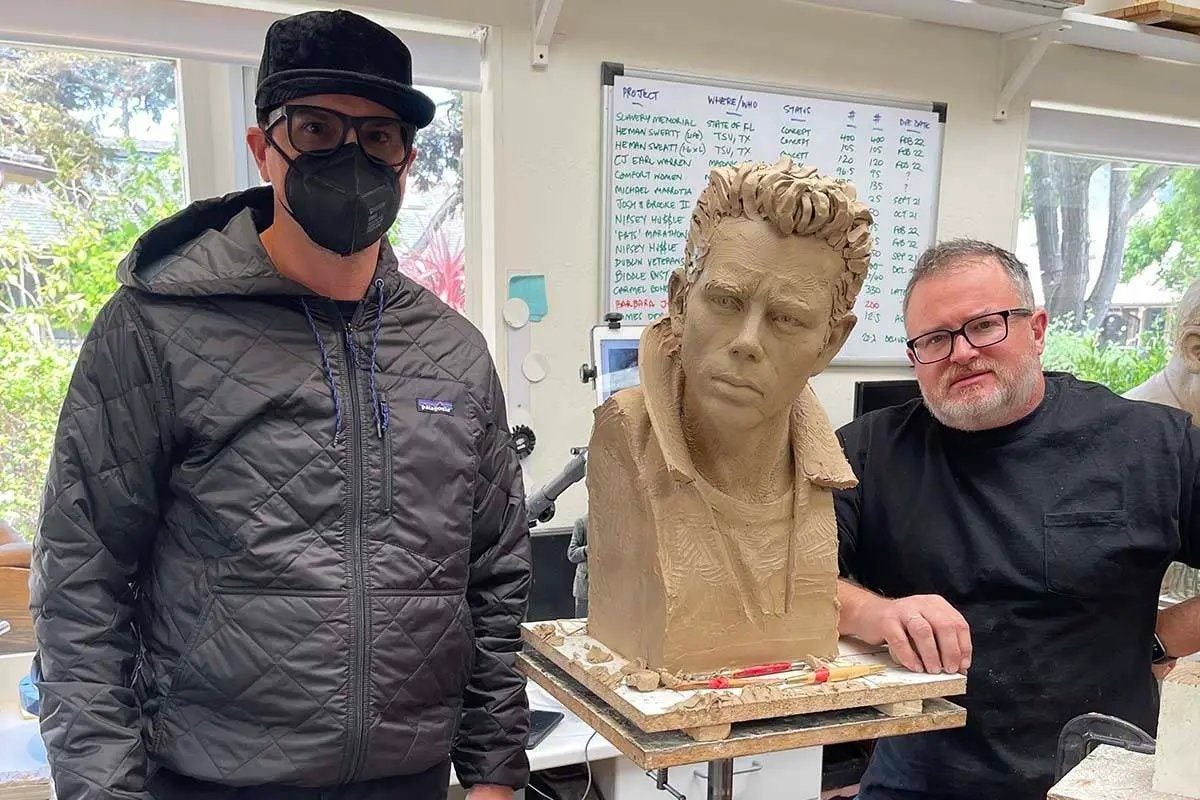The Ghost of James Dean
Whether supernatural or digital, this week saw several efforts to capitalize on the spirit of James Dean.
When my article about James Dean ran in Esquire on Sept. 30, it arrived alongside a bizarre piece in Fortune magazine announcing that Dean would be appearing in a new movie, Back to Eden. Travis Cloyd, a CGI artist and filmmaker, has partnered with CMG Worldwide, the management company that controls the rights to Dean’s image, to recreate Dean as a digital avatar that will “act” in the movie. The story is cringeworthy: A writer driving past the site where Dean died in a car crash on Sept. 30, 1955 discovers a baby has mysteriously appeared in the back seat of his car. The miracle child grows over the course of a few days into an adult.
It turns out the new human is indeed Dean, who returned to life to experience everything his untimely loss denied him. Meanwhile, instead of living in the 1950s, Dean 2.0 is driving a Tesla, using an iPhone, and reading what is—still, decades after his death—being written about him on social media.
The film, produced by Cloyd and Dean’s cousin Marcus Winslow, is slated for release next year, and the Cloyd and the Dean Estate plan a “multimedia campaign” to promote both the project and James Dean. Cloyd has been pursuing versions of this project for several years, and last year he said that the multimedia campaign will include multiple movie roles for Dean and both videogames and virtual reality media.
Honestly, I think this is rather grotesque. I can see reasons to digitally recreate a dead celebrity, perhaps for a historical drama where characters interact with historical figures. I’m not knee-jerk opposed to digital actors, though so far none has been good enough to avoid the uncanny valley. But the Back to Eden story is so very, very weird—and reeking of an attempt to keep milking an $8.5 million per year cash cow by reintroducing him to a new generation unfamiliar with their grandparents’ celebrities—that it feels more like exploitation than art. At least Star Wars had a purpose in recreating dead actors.
Cloyd said he is “ecstatic” about the project, which now has funding and has begun preproduction, with filming set to begin next year. An NFT of a digital image of Dean’s Porsche is going up for sale this month—presumably for more than the $20,000 a set of 1955 photographs of its wreckage brought at auction last weekend—and Cloyd explained that the best part is that using a licensed digital actor means that in the future, no one will need to pay real actors for marketing and promotion when they can simply be animated into promoting a product.
The real Porsche 550 Spyder, rather than its NFT, also had its own moment of fame, or infamy, this weekend. This weekend, TV ghost hunter Zak Bagans opened a new exhibit at his Las Vegas museum dedicated to the transaxle assembly from James Dean’s crashed Porsche, which he bought for an obscene amount of money—more than $300,000. At the time, Bagans called the piece one of the most-cursed objects in America and salivated about its supernatural power.
I suppose it is progress that Bagans’s museum is now putting “cursed” in quotation marks in its social media postings. Perhaps my Las Vegas Journal-Review article pointing out the disturbing homophobic undercurrents of the fake curse story had at least a small effect, at least insofar as he needs to avoid alienating the audience on Discovery+, where he has a new scripted horror series with Eli Roth inspired by the museum, and hosting Halloween Wars on Food Network, a channel whose audience, let’s say, wouldn’t be too keen on homophobic nonsense.
While Bagans isn’t pushing the “cursed” Porsche narrative as strongly now, he recently visited the site of James Dean’s death to try make contact with his ghost, apparently hoping to develop a “haunting” story. Oh, and he commissioned this godawful bust for his museum.
Bagans told a newspaper that he had planned a pharaonic ceremony to install Dean’s transaxle assembly in his museum. He wanted to speak with Dean’s ghost at his death site and then have a motorcycle parade accompany the part to Las Vegas, like a presidential motorcade. He told the Las Vegas Review-Journal that he had “visions” of the motorcade from the spirit realm. Sadly, ghost Dean apparently spent his time getting my article into Esquire since he didn’t make the performance happen.
For all the money Bagans poured into the exhibit, backing off on the “curse” story reduced his PR campaign to one newspaper article in a local paper and a couple of tweets. I can’t say I’m sad about that.





I worry about this as well. What prevents using a living (but perhaps retired) actor in uncontracted roles such as making Robert Downey Jr. seem to appear in Marvel Multiverse or What If? roles, as has been suggested? Current laws may not make such use preventable, just as music publisher copyrights went down the drain with digital downloads. I remember when Nat King Cole's daughter did that virtual duo with her late Dad and raised such a fuss. What if Lady Gaga wanted to do one more "Last Concert" with Tony after his death? Slippery slopes.
The museum sounds more than a bit creepy. Nothing wrong with commissioning the bust, although a much better one was already made from life by the great but little known artist Kenny Kendall. I put out feelers about that original and another made for Steve Reeves with the artist only to see both hawked on Pawn Stars years later. The bronze copy of the Dean bust by Kendall was put up at the Griffith Observatory and promptly stolen and had to be replaced.